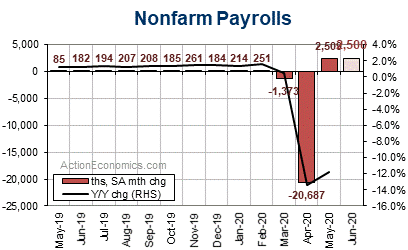The lean 167k July ADP payroll rise undershot our 1,900k private BLS payroll estimate with a 2,600k total BLS payroll gain. We also saw the expected big boost in the June ADP gain to 4,314k from 2,369k that narrowed the gap to the 4,767, BLS private payroll increase in that month. The ADP climb defied the improvement in the continuing and initial claims data for the period and other evidence that production continued to rise despite delays in re-openings for the retail sector.
The ADP figures have done a poor job of signaling monthly BLS payroll changes, and we still expect a further July climb in payrolls barring any surprises with tomorrow’s claims data. There is a 12-month average “as reported” ADP drop through June of -1,608k, versus a 12-month average drop for BLS private payrolls of -973k. ADP undershoots of BLS payroll growth of -2,398k in June, -5,992k in May and -401k in April, but an overshoot of 1,330k in March.
Meanwhile the July nonfarm payroll estimate sits at 2,600,000 according to Action Economics following gains of 4,800,000 in June and 2,699,000 in May, as most measures of output continued to climb into July despite setbacks in the reopening process for the retail sector, and the seasonal factors should boost government jobs as April’s teacher layoffs are usually reported in July. Yet, improvement in initial and continuing claims slowed, as did most measures of foot traffic. The jobless rate should fall to 10.2% from 11.1% in June. We expect a 1.5% July hours-worked increase with a 34.5 workweek, while hourly earnings give back more of the 4.7% April pop with the shift in the composition of jobs, as more low-paid workers return to work. We assume a -0.4% decline that extends June’s -1.2% drop.

The 2,600,000 Nonfarm payroll forecast assumes a 1,900k private jobs increase. The goods based employment increase is pegged at 350k, after a 504k increase in June. Construction employment is seen rising 60k, after a 158k increase in June, factory jobs rise 300k, after a 356k June increase, private service job increase of 1,550k in July, after a 4,263k increase in June, while a 700k government employment rise is seen that is boosted by a continued reversal of the April plunge in education employment. The seasonal factors assume that these annual exits are mostly in July, following typically smaller exits in May and June.
Hourly Earnings
A -0.4% decrease is anticipated in July average hourly earnings, after drops of -1.2% in June and -1.0% in May, as we further unwind the 4.7% April surge. Job losses have been skewed toward lower paid retail, leisure and hospitality workers, and this prompted the April spike in average hourly earnings that is now being partly reversed. Growth in hourly earnings was gradually climbing from the 2% trough area between 2010 and 2014 to the 3%+ area, until the economy’s plunge in March. As shutdown distortions dissipate the underlying cyclical uptrend will presumably fall back to the 2% area, though y/y gains will be distorted through 2021 by this year’s Q2 wage spike and ensuing unwind.
Click here to access the Economic Calendar
Andria Pichidi
Market Analyst
Disclaimer: This material is provided as a general marketing communication for information purposes only and does not constitute an independent investment research. Nothing in this communication contains, or should be considered as containing, an investment advice or an investment recommendation or a solicitation for the purpose of buying or selling of any financial instrument. All information provided is gathered from reputable sources and any information containing an indication of past performance is not a guarantee or reliable indicator of future performance. Users acknowledge that any investment in Leveraged Products is characterized by a certain degree of uncertainty and that any investment of this nature involves a high level of risk for which the users are solely responsible and liable. We assume no liability for any loss arising from any investment made based on the information provided in this communication. This communication must not be reproduced or further distributed without our prior written permission.



















